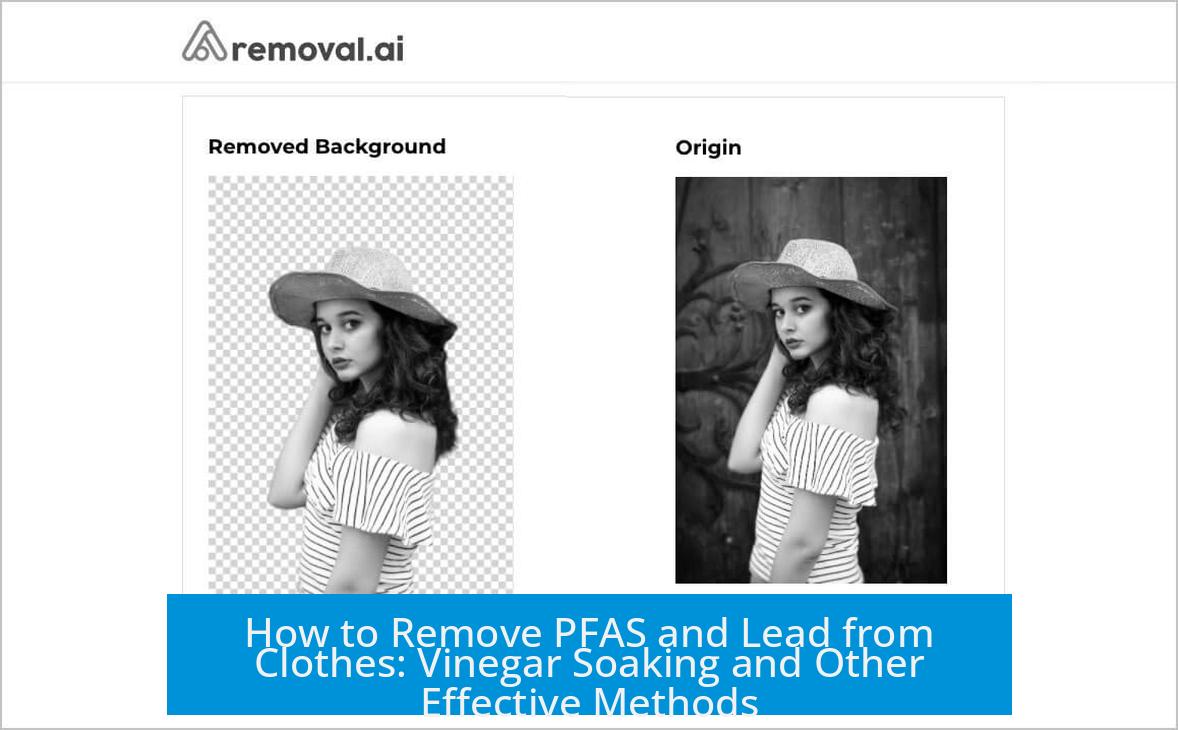How to Remove Toxic Chemicals Like PFAS or Lead from Clothes: The Facts About Vinegar Soaking and Other Methods

Removing toxic chemicals such as PFAS (per- and polyfluoroalkyl substances) or lead from clothes is extremely difficult. Vinegar soaking does not effectively remove these contaminants, and harsh chemical treatments needed to degrade PFAS damage fabrics. In the case of lead, exposure via clothing is mostly linked to metallic parts rather than fabric dyes, and specialized approaches or disposal is required for significant contamination.
Understanding PFAS and Lead in Clothing
PFAS are synthetic chemicals used in water-resistant and stain-repellent textiles. They are often called “forever chemicals” due to their persistence in the environment and difficulty to break down.
- Clothing labeled as water-resistant commonly contains PFAS.
- Many countries, especially in the EU, provide information about PFAS presence in consumer products.
- Lead in clothing is much less common, typically confined to metallic components like snaps or zippers rather than dyes.
- Lead-based dyes in textiles are rare or obsolete due to toxicity regulations.
Why Vinegar Soaking Does Not Remove PFAS or Lead
Vinegar mainly contains 3%-5% acetic acid, a weak acid mostly used in cooking and cleaning.
- Acetic acid does not chemically break down PFAS or lead compounds.
- Soaking clothes in vinegar changes neither the chemical structure nor the binding of these contaminants to fabric fibers.
- The claim that vinegar can remove such toxic chemicals is unsupported by scientific evidence and likely a misconception.
- Vinegar soaking may slightly alter fabric dyes or cause odor without detoxifying the material.
Simply put, vinegar acts as a mild cleanser but is ineffective for removing ‘forever chemicals’ or metallic lead.
Scientific and Chemical Methods for PFAS Removal: Limits and Consequences
PFAS removal requires chemical processes capable of breaking down strong fluorinated carbon bonds.
| Method | Effectiveness | Impact on Fabric | Practicality for Consumers |
|---|---|---|---|
| Hydrolysis with concentrated sodium hydroxide (NaOH) and organic solvents (e.g., methanol) | Can degrade side-chain fluorinated PFAS polymers | Damages polyester and other synthetic fabrics severely | Not feasible for home use; degrades garment integrity |
| Repeated oil soaking followed by warm soapy washes | May dislodge some PFAS, but unproven and inefficient | Time-consuming and may damage fabric | Impractical and troublesome for typical consumers |
| Normal washing with clean water and detergent | Partial removal of volatile PFAS, but incomplete | Minimal fabric damage | Only modest reduction in PFAS; best option without damage |
The takeaway is that chemicals required for full PFAS removal destroy the clothing. Consumers have limited practical options beyond avoiding PFAS-treated textiles.
Lead Contamination in Clothing: What Matters Most
Lead rarely occurs in fabric dyes due to modern regulations restricting toxic heavy metals in textiles.
- Lead concerns focus on metallic clothing parts that might contain solder or coatings.
- Ingestion avoidance is the principal safety measure — do not put metal parts in your mouth.
- Environmental lead exposure may deposit water-soluble lead salts onto clothes; these might be partially washed out with clean water.
- If clothing is contaminated by lead-based paint or industrial lead, disposal is the safest option.
Advanced chemical treatment for lead removal is hazardous and impractical, involving strong acids harmful to fabric and human health.
Effectiveness of Washing and Aging on PFAS in Textiles
Scientific studies show mixed results regarding washing clothes to remove PFAS:
- Washing tends to reduce some volatile perfluoroalkyl acids (PFAAs), hence lowering surface contaminant levels.
- In some cases, washing may increase extractable PFAS content inside fabrics due to redistributing these chemicals.
- The efficiency largely depends on fabric type and PFAS species present.
- Using PFAS-free water maximizes washing effectiveness; contaminated water may reintroduce toxins.
Regular laundering provides only partial and inconsistent PFAS removal.
Recommendations for Consumers Concerned About PFAS or Lead
- Do not rely on vinegar or household soaking methods. These do not remove PFAS or lead effectively.
- Avoid purchasing PFAS-treated water-resistant clothing when possible, or seek certified PFAS-free labels.
- Dispose of heavily contaminated clothing, especially if exposed to industrial PFAS or lead paints.
- Wash clothes normally with detergent and clean water for modest reduction of surface contaminants.
- Avoid chewing or mouth contact with metallic clothing components to minimize lead risk.
- Advocate for environmental regulations addressing PFAS and lead contamination to reduce widespread exposure.
Environmental and Health Context: What You Should Know
PFAS and lead are persistent, bioaccumulative toxins. Removing them from textiles or the body is complicated.
- PFAS represents a broad chemical class used in many products, making avoidance difficult.
- Lead exposure relates more to environmental contamination than clothing.
- Anxiety about invisible contaminants is understandable but excessive concern without action can be counterproductive.
- Public policy and systemic change remain the most effective solutions to reducing toxic chemical exposure.
Scientific Resources for Further Reading
- PFAS Toxicity and Exposure (The Guardian)
- Effect of Washing on PFAS in Textiles (NCBI)
- Advice on PFAS Exposure (Clean Water)
Key Takeaways
- PFAS chemical bonds are highly stable; effective degradation requires harsh chemicals unfit for garment care.
- Vinegar soaking does not remove PFAS or lead contaminants; it is ineffective and may damage fabrics.
- Lead contamination in clothing is mainly a concern for metal parts; textile lead dyes are uncommon.
- Regular washing may reduce some PFAS but does not eliminate contamination.
- The best approach is prevention: choose PFAS-free clothing and avoid lead exposure sources.
- Environmental and regulatory efforts are crucial to limit persistent toxic chemical exposure.
Can soaking clothes in vinegar remove PFAS or lead contamination?
No, vinegar is a weak acid and does not break down PFAS or lead. Soaking clothes in vinegar will not remove these chemicals. It may only leave a smell and could harm fabric or dyes.
Is washing clothes effective at reducing PFAS contamination?
Washing can reduce some PFAS levels over time, especially if PFAS is not in your water supply. However, washing won’t remove all PFAS and might sometimes increase extractable PFAS in fabrics.
Are there chemical treatments to remove PFAS from clothing safely at home?
Removing PFAS requires strong chemicals like concentrated sodium hydroxide with solvents. These treatments damage fabric and are not practical for consumers. Avoid buying PFAS-treated textiles instead.
Should I worry about lead in clothing, and how can I remove it?
Lead is usually only a concern in metallic parts of clothing. Lead-based dyes are uncommon, and washing with lead-free water may help with surface contamination. Avoid putting metal parts in your mouth.
Are there easy, safe ways to remove these toxins from clothes?
No simple or safe method exists to fully remove PFAS or lead from clothes. The best option is to avoid contaminated clothing or discard heavily exposed items. Vinegar and home remedies are ineffective.





Leave a Comment